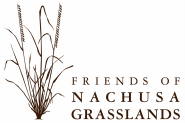Stop 2 — Oak Savanna
As you enjoy this hike, you may pass in and out of savannas and woodlands. Savannas usually transition the woodland to the prairie. Keep looking up at the tree canopy cover to determine if you are in a woodland, prairie or savanna.
|
Historically, oak savannas were very common in the midwestern states. However, after the early settlers arrived, their home construction, agriculture, and lack of fire soon damaged the oak trees and their understory plants — the oak savannas began to disappear. Now, oak savannas in the Midwest are very rare.
How is an oak savanna different from a woodland? LOOK UP AT THE TREE CANOPY. The savanna tree canopy will cover 10%-50% of the sky, with the trees well–spaced from one another.
|
LOOK AT THE UNDERSTORY.
Try to find the Pennsylvannia Sedge! (Carex pennsylvanica) This sedge (a grass–like plant with triangular stems) grows along the hill slopes and is the dominant ground cover in a black oak savanna. This sedge spreads clonally and forms large patches. Stop 3 — St. Peter Sandstone Back to Tour Page |
